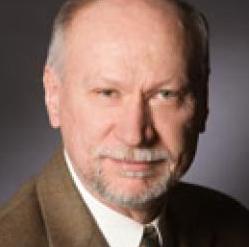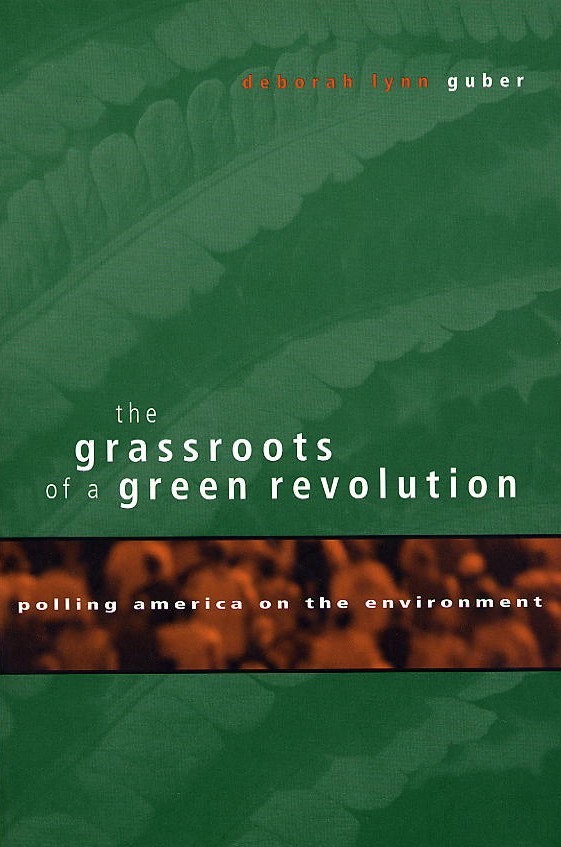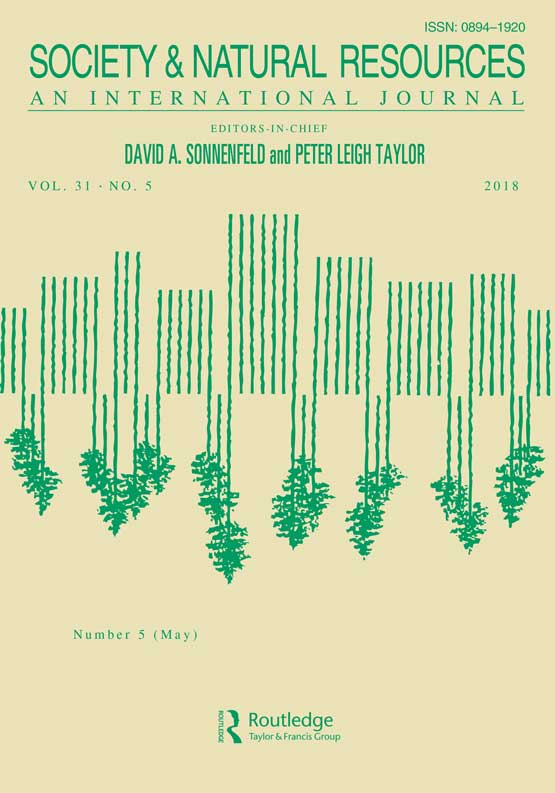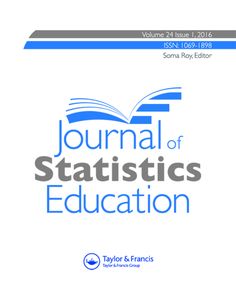“Guber provides a critical look at what public opinion polls have been telling us—or not telling us—about Americans’ concern about the environment. How deep and how enduring is this concern, and what difference does it make in our lifestyles, in the voting booth, and in the marketplace? These questions are all examined thoroughly. This book provides the most comprehensive and thought-provoking look at public opinion on the environment to date.”

Paul Mohai
School of Natural Resources and Environment, The University of MichiganBook
Deborah Lynn Guber. 2003. The Grassroots of a Green Revolution: Polling America on the Environment. Cambridge, MA: The MIT Press.
ISBN: 9780262571609
DOI: https://doi.org/10.7551/mitpress/3351.001.0001

Since the first Earth Day in 1970, environmentalism has become woven into the fabric of American life. Concern for environmental quality has spawned extraordinary changes in how we think, work, and recreate, in what we buy, and how we govern. But popular consensus on the environment is more complicated than it appears. The real question is no longer whether Americans side with environmentalism, but rather what kind of commitment they bring to the table. This book argues that understanding public opinion—the grassroots of the “green” revolution—is essential to sustaining genuine environmental progress. The long-term success of the environmental movement will be measured not only by its legislative achievements, but by its ability to persuade average Americans to back up their words with action, and to further alter their voting patterns, buying habits, and lifestyles.
The Grassroots of a Green Revolution uses polling data from a wide variety of sources to explore the myths, inconsistencies and tensions that characterize public thinking on environmental issues. The book defines and describes key characteristics of public opinion—including direction, strength, stability, distribution, and consistency—and traces the way in which those qualities influence the behavior of citizens and consumers alike. In the end, that body of evidence is used to weigh the significance of environmental concern within the arena of U.S. politics and policymaking, and to provide pragmatic advice for decisionmakers in their efforts to motivate Americans to act in an environmentally responsible way.
PEER-REVIEWED Articles
Deborah Lynn Guber. 2021. “Public Opinion and the Classical Tradition: Redux in the Digital Age,” Public Opinion Quarterly, 85 (4): 1103-1127. DOI: 10.1093/poq/nfab053.
Published online: November 25, 2021.

Digital trace data have the potential to offer rich insight into complex behaviors that were once out of reach, but its use has raised vital and unresolved questions about what is—or is not—public opinion. Building on the work of James Bryce, Lindsay Rogers, Herbert Blumer, Paul Lazarsfeld, and more, this essay revisits the discipline’s historical roots and draws parallels between past theory and present practice. Today, scholars treat public opinion as the summation of individual attitudes, weighted equally and expressed anonymously at static points in time through polls, yet prior to the advent of survey research, it was conceived as something intrinsically social and dynamic. In an era dominated by online discussion boards and social media platforms, the insights of this earlier “classical tradition” offer two pathways forward. First, for those who criticize computational social science as poorly theorized, it provides a strong justification for the work that data scientists do in text mining and sentiment analysis. And second, it offers clues for how emerging technologies might be leveraged effectively for the study of public opinion in the future.
Deborah Lynn Guber, Jeremiah Bohr, and Riley E. Dunlap. 2021. “‘Time to Wake Up’: Climate Change Advocacy in a Polarized Congress, 1996-2015.” Environmental Politics, 30 (4): 538-558. DOI: 10.1080/09644016.2020.1786333. Published online: July 7, 2020.

Scholars who study the failure of climate change policy in the United States tend to focus on the mechanics of denial and the coordinated efforts of political operatives, conservative think tanks, and partisan news outlets to cast doubt on what has become overwhelming scientific consensus. In contrast, this work seeks to address a factor that has been understudied until now—the role of climate change advocacy in the U.S. Congress. Using quantitative text analysis on a corpus of floor speeches published in the Congressional Record between 1996 and 2015, we find notable differences in the language partisans use. Democrats communicate in ways that are message-based, emphasizing the weight of scientific evidence, while Republicans tend towards a softer, cue-based narrative based on anecdotes and storytelling. We end with a discussion of what climate change advocates can hope to accomplish through the “politics of talk,” especially in an age of heightened polarization.
Deborah Lynn Guber. 2017. “Partisan Cueing and Polarization in Public Opinion about Climate Change.” In, The Oxford Research Encyclopedia of Climate Science. New York: Oxford University Press. DOI: 10.1093/acrefore/9780190228620.013.306.
*invited contribution

Despite an accumulation of scientific evidence on both the causes and consequences of climate change, U.S. public opinion on the subject has splintered sharply along party lines. While a vast majority of Democrats now believe that global warming is real, that its effects will happen within their lifetime, and that human activity is the dominant cause, Republicans have grown increasingly skeptical, creating a yawning gap that complicates efforts to communicate the urgency of the problem and the need for aggressive action.
When attitudes harden and diverge, it is often driven by the behavior of political elites, who shape the frames and mental models that people use to interpret events. Scholars have long observed that people resort instinctively to heuristics to ease the burden of making decisions, especially on issues like climate, where there is an obvious disconnect between scientific understanding and mass competence. Those cues, however, are often unreliable and prone to cognitive bias. When voters act upon signals provided by their preferred political party and by selective exposure to preferred media outlets, they may do so mechanically, with little regard for the accuracy of the evidence that they receive, or they may ignore and distort information in a way that reinforces preexisting assumptions.
In the end, beliefs about climate change are as complex as the issue itself, which suggests that awareness of the problem and an understanding of its effects will not translate automatically—or even easily—into increased concern, issue salience, or policy preferences. The “pictures in our heads,” to borrow Walter Lippmann’s famous phrase, are shaped less by factual knowledge than by a variety of other factors more difficult to control—by personal experience and assorted real-world cues (such as the weather), but also by opinion leaders, media narratives, and political rhetoric, each of which provides a competing frame of reference with the power to filter and mislead. Because climate change has become so heavily laden with values and so absorbed into partisan identity, it will be nearly impossible to build social consensus through conventional means. Once a “hard” issue for all, which seemed to demand sophisticated calculation or technical expertise, it has now become an “easy” one for many, where the reactions that it prompts are familiar, stable, and symbolic, increasingly polarized, immune to rational argument, and vulnerable to manipulation by elites.
Deborah Lynn Guber. 2013. “A Cooling Climate for Change? Party Polarization and the Politics of Global Warming.” American Behavioral Scientist, 57 (1): 93-111. DOI: 10.1177/0002764212463361

Analysis of three cross-sectional polls administered by the Gallup Organization at 10- year intervals—in 1990, 2000, and 2010—demonstrates that partisan identification has become an increasingly important determinant of environmental concern within the American mass public. Polarization on global warming is especially clear, even when compared to a variety of other social, economic, and political problems, but party sorting seems to occur only as citizens acquire information and become familiar with elite cues. The implications of this for the U.S. environmental movement and the strategies it employs are discussed.
Deborah Lynn Guber. 2010. “’Make of Them Grand Parks, Owned in Common’: The Role of Newspaper Editorials in Promoting the Adirondack Park, 1864-1894.” Journal of Policy History, 22 (4): 423-449. DOI: 10.1017/S0898030610000217

Scholars have long viewed the creation of public parks in the 19th century as a reflection of American democratic ideals. A commitment to egalitarianism on the one hand meant that natural wonders could be set aside for the use and enjoyment of all people, not just for the wealthy few, or for royalty. Meanwhile, institutions governed by popular sovereignty reminded lawmakers that growing public demands for forest preservation should be heeded. Yet according to some environmental historians (such as Roderick Nash), parks and democracy are more than compatible ideas; they connect in ways that are explicitly causal. This paper explores what might be called the “democracy thesis” through a narrative case study of the Adirondack Park. A content analysis of 19th century newspaper editorials published in New York between 1864 and 1894 reveals that democratic rhetoric was frequently invoked in support of the creation of a public park in the Adirondacks, but that argument ultimately had little influence on state legislators. Not only does Nash overemphasize consensus on democratic norms and traditions, he overlooks important class and regional conflicts that continue to shape the tension between conservation and preservation today.
Deborah Lynn Guber. 2001. “Voting Preferences and the Environment in the American Electorate.” Society & Natural Resources, 14 (6): 455-469. DOI: 10.1080/08941920152120484

Despite evidence of a growing environmental consensus in the United States, students of electoral politics have long debated the political significance of environmentalism by noting the near absence of this issue from national political campaigns. Unfortunately, with only limited survey data available in the past, the few studies to address environmental voting did more to report a deficiency than to explain why it should be the case. In this study I use 1996 National Election Study (NES) data to examine the impact of environmental concern on attitudes toward American political parties and their candidates. Data results on issue positions and proximities confirm that while environmental issues represent a strength of the Democratic ticket, those issues seldom shape individual vote preferences for three reasons: (1) low issue salience; (2) small perceived differences between candidates on matters of environmental policy; and (3) the tendency of environmental concern to cut across traditional (and more powerful) cleavages, including partisan identification.
Deborah Lynn Guber. 2001. “Environmental Voting in the American States: A Tale of Two Initiatives.” State and Local Government Review, 33 (2): 120-132. DOI: 10.1177/0160323X0103300204

Students of electoral behavior on statewide ballot propositions have long suspected that in the absence of typical cues and informational shortcuts, voters are more dependent on political campaigns to simplify choice and shape electoral decisions. This article uses survey data from two prominent and contrasting case studies in California and Massachusetts to test that hypothesis by examining the importance of issue framing in initiative campaigns. In the end, results suggest that while factors such as campaign spending may be important in understanding the broad conditions under which these measures succeed or fail, it is sometimes the content of the message that matters most.
Deborah Lynn Guber. 1999. “Getting What You Pay For: The Debate Over Equity in Public School Expenditures.” Journal of Statistics Education, 7 (2). DOI: 10.1080/10691898.1999.12131274

Using data from the 1997 Digest of Education Statistics, this teaching case addresses the relationship between public school expenditures and academic performance, as measured by the SAT. While an initial scatterplot shows that SAT performance is lower, on average, in high-spending states than in low- spending states, this statistical relationship is misleading because of an omitted variable. Once the percentage of students taking the exam is controlled for, the relationship between spending and performance reverses to become both positive and statistically significant. This exercise is ideally suited for classroom discussion in an elementary statistics or research methods course, giving students an opportunity to test common assumptions made in the news media regarding equity in public school expenditures.
Deborah Lynn Guber. 1996. “Environmental Concern and the Dimensionality Problem: A New Approach to an Old Predicament.” Social Science Quarterly, 77 (3): 644-662.

Objective. Much previous work in the field of survey research has puzzled over modest bivariate correlations between different environmental measures, suggesting that public attitudes on the environment are rather crude, disconnected, and narrowly focused. Using 1991 Gallup data, the purpose of this research is to present a methodological critique and reevaluation of the literature on the dimensionality of environmental concern. Methods. Given the frequent, yet problematic, use of environmental batteries that ask respondents to express opinions using a common response format, this paper uses confirmatory factor analysis to correct for both random and nonrandom sources of measurement error. Results. Data results suggest that not only can the standard environmental battery used by Gallup be reduced to relatively few latent fac- tors, those factors are themselves strongly correlated across a diverse set of environmental issues, as well as among several broad idea elements thought to define environmental concern. Conclusions. While current results offer compelling evidence of the near uni-dimensionality of environmental attitudes, and of the willingness of many Americans to express concern for environmental quality, ultimately dimensionality alone may be insufficient proof that public attitudes on the environment have matured into a sophisticated and constrained social paradigm or belief system.
Chapters in Edited Volumes
Deborah Lynn Guber and Christopher J. Bosso. 2012. “Issue Framing, Agenda-Setting, and Environmental Discourse.” In, The Oxford Handbook of U.S. Environmental Policy, Michael E. Kraft and Sheldon Kamieniecki, editors. New York: Oxford University Press, 437-460.
*invited contribution

To identify a problem, diagnose its cause, attribute blame, and propose a solution is to engage in a long and complex chain of events that lie at the very heart of political life and public affairs. The goal of this chapter is to identify key scholarship in the field. We do so by connecting two broad interdisciplinary threads. First, we tackle the subject of issue framing, which focuses on the formation of public attitudes and the way in which issues are packaged and presented for mass consumption. Second, we address agenda setting, which centers on political elites and the decisions that are made—or deferred—within the policy-making process. Finally, we draw on both to suggest productive avenues for future research.
Deborah Lynn Guber and Christopher J. Bosso. 2012. “’High Hopes and Bitter Disappointment:’ Public Discourse and the Limits of the Environmental Movement in Climate Change Politics.” In, Environmental Policy: New Directions for the Twenty-First Century, 8th edition. Norman J. Vig, and Michael E. Kraft, eds. Washington, DC: CQ Press, 54-82.
*invited contribution

If the window of opportunity for major policy change opened dramatically with the election of President Obama and the enlargement of Democratic majorities in both chambers of Congress following the 2008 election, it shut remarkably fast, reminding us that environmental politics can only be understood within broader ideological and partisan contexts. In this chapter, we view the efforts by competing sides in the climate change debate to shape public opinion, to mobilize allies in support of their positions, and to control the venues of formal decision-making as reflections of a broader struggle over the very purpose of government. How that fundamental struggle plays out will define whether the failure of the climate change bill was a momentary bump in the road or a harbinger of a fundamental reordering of priorities and policies.
Deborah Lynn Guber and Christopher J. Bosso. 2009. “Past the Tipping Point: Debating the Future of Public Discourse on the Environment.” In, Environmental Policy: New Directions for the Twenty-First Century, 7th edition. Norman J. Vig, and Michael E. Kraft, eds. Washington, DC: CQ Press, 51-74.
*invited contribution

In this chapter we explore the politics of climate change as emblematic of a new age of environmentalism in the United States, and the opportunities and constraints it imposes on political actors and the institutions they inhabit. In doing so, we look to the vagaries of public opinion on environmental issues, the difficulty of translating broad public support into substantive policy outcomes, and the role of the environmental movement in linking mass attitudes to government action. For everyone involved, much—but certainly not all—of the political opportunity structure shaping environmental policymaking was reconfigured dramatically with the election of President Barack Obama and the solidification of Democratic majorities in both chambers of Congress. Taken as a whole, the events of 2007 and the results of the 2008 election solidified a momentous shift from the previous eight years. Even so, and even as we argue that the debate over the science of global warming is indeed at an end, a wider and more significant ground war over public opinion, the range of policy options, and the framing of political discourse has just begun.
Deborah Lynn Guber and Christopher J. Bosso. 2007. “Framing ANWR: Citizens, Consumers, and the Privileged Position of Business.” In, Business and Environmental Policy: Corporate Interests in the American Political System. Michael E. Kraft and Sheldon Kamieniecki, editors. Cambridge, MA: The MIT Press, 35-60.
*invited contribution, peer-reviewed

Drawing on theories of agenda-setting and issue framing, we use the Arctic National Wildlife Refuge as a case study to explore the conditions under which business groups influence environmental policy. In the end, we argue that the public’s ambivalence on energy and the environment, embodied in a tension between the public-minded “citizen” and the self-regarding “consumer,” enabled the oil lobby to step back from ANWR and pursue a strategy of triangulation instead, where advertising campaigns and high-profile donations to mainstream environmental groups were used to mend corporate reputations, while distracting attention away from quieter efforts to direct the agenda of government in their favor.
Christopher J. Bosso and Deborah Lynn Guber. 2005. “Maintaining Presence: Environmental Advocacy and the Permanent Campaign.” In, Environmental Policy: New Directions for the Twenty-First Century, 6th edition. Norman J. Vig, and Michael E. Kraft, eds. Washington, DC: CQ Press, 78-99.
*invited contribution

This chapter examines the opportunities and constraints facing environmentalists in the early twenty-first century. We look first at trends in public opinion on environmental issues and at how a sagging economy at home and the war on terrorism abroad have insulated the president from public disapproval of his environmental record. By emphasizing the importance of agenda-setting and issue framing, we then discuss the challenges environmentalists face in translating environmental concern into concrete support for political candidates and their policies. In doing so, we look at factors that influence the electoral behavior of voters, but also at the larger constraints of party politics, where environmentalists have long debated whether they should promote their agenda within the existing two-party system, or promote Green Party candidates instead. Between elections, of course, environmental groups are like any other organized interest, and so we evaluate also the strategies used by major organizations that comprise the national environmental advocacy community. Granted little access to decision making under the Bush administration, they face more difficult political terrain than any other in a generation.
Christopher J. Bosso and Deborah Lynn Guber. 2003. “The Boundaries and Contours of American Environmental Activism.” In, Environmental Policy: New Directions for the Twenty-First Century, 5th edition. Norman J. Vig, and Michael E. Kraft, eds. Washington, D.C.: CQ Press, 79-101.
*invited contribution

Disruptions in the nation’s priorities and finances after September 11, 2001 have created the most daunting political challenge for environmentalists in the contemporary environmental era. Our task in this chapter is to make some sense of the boundaries and contours of this political terrain. By boundaries we mean the range of opportunities for and limits on activists imposed by mass public opinion on the environment. By contours we mean the variegated topography of environmental activism itself, ranging from national organizations to grassroots groups, as well as the fissures among these diverse elements. Finally, we conclude with thoughts about the immediate challenge to environmental activism in the United States.

